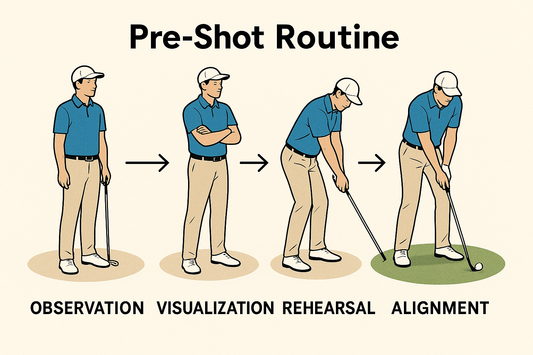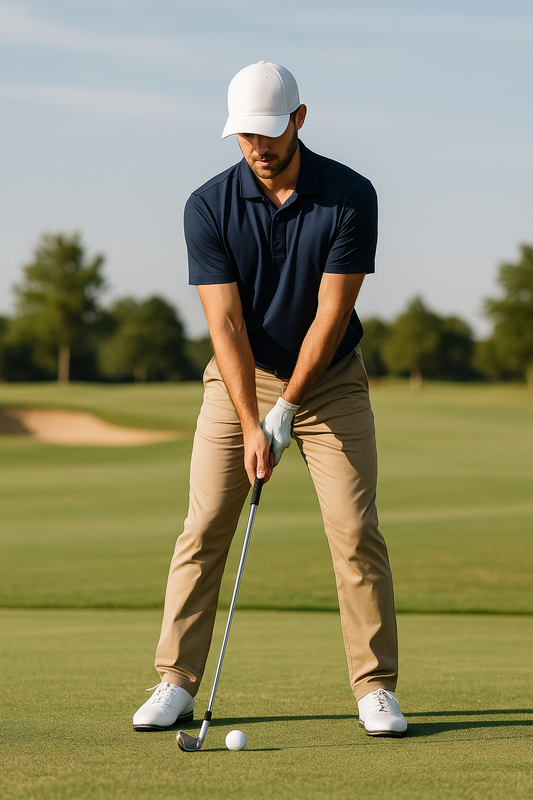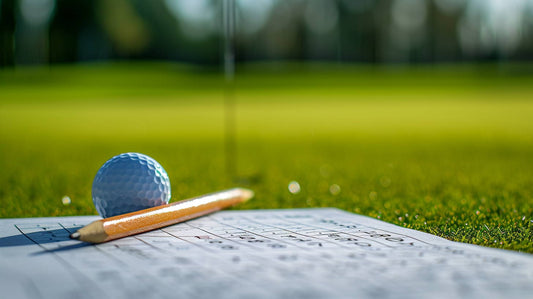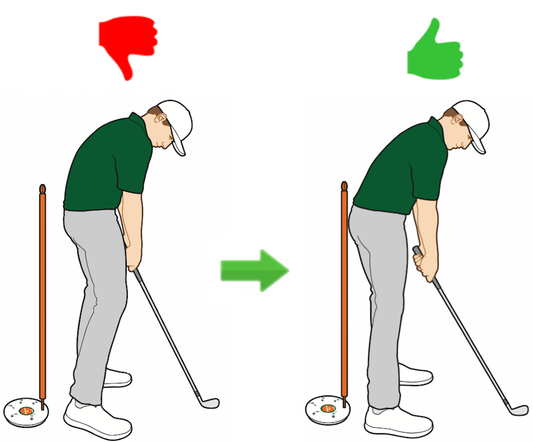Author: WhyGolf WhysGuy
We want to preface this guide with the acknowledgment that neither WhysGuy nor anyone from the WhyGolf team claims to know everything about the golf swing. We don’t want anyone to treat what we say here as gospel. While much of what we’ll say is a reflection of decades of dialogue with PGA instructors and players, we’re always learning and we understand that knowledge about the sport of golf will continue to evolve over time.
In this post, WhysGuy will cover:
- What golf's Ball Flight Laws are and why it's important to understand them.
- How understanding the Ball Flight Laws is essential to diagnosing your swing issues.
- How you can quickly identify your club's face angle and swing path after a golf shot.
Picture this:
You've been hitting banana slices to the right all day. All hope for a day of respectable ball-striking has vanished.
However, as you approach the 14th tee box, you're struck with a novel thought.
Maybe I just need to aim farther left.
You make a valiant swing at the ball, but, much to your chagrin, yet another ball slices even farther right into the neighboring county.
If this sounds familiar, it's highly likely you'd benefit from a quick brush-up on Ball Flight Laws.
When a right-handed golfer is fighting a slice and opts to align themselves farther left, they're typically going to end up swinging the club farther left (out-to-in), which is a recipe for an even bigger slice.
Put simply, Ball Flight Laws explain the dynamic between the club's face angle and swing path at impact and also describe the conditions necessary to hit different ball flights.
Why Are Ball Flight Laws Important?
Understanding ball flight laws is critical if a golfer wants to be able to self-diagnose their swing faults. After hitting a wayward golf shot, if a player is unable to determine what happened to their club's face angle and swing path at impact, they won't be able to make educated swing adjustments.
Though it may sound counter-intuitive, a right-handed golfer looking to hit a fade needs to ensure that their club's face angle at impact is pointed left of their target and their swing path direction needs to be left of their face angle.
Why? If we're trying to make the ball move left-to-right and ultimately end up at our target, the ball will need to start left of our target (thus, the face angle needs to be pointed left of target). To make the ball curve to the right, our swing path needs to be left of the face angle at impact.
Key Terms:
Before we begin discussing the flight laws, let's discuss a couple key terms:
- Face Angle - The direction your clubface is pointing at impact.
- Swing Path - The direction your clubhead is moving in at impact. When people say "You're cutting across it", they're specifically referring to swing path.
The Ball Flight Laws
Before the advent of high-speed golf tracking technology such as TrackMan, the belief was that a player's swing path at impact determined the initial starting direction of the ball. This idea has been debunked by TrackMan studies.
It's been proven that the club's face angle at impact is primarily responsible for the ball's starting direction, and the resulting shot curvature reflects the swing path direction relative to the club's face angle.
Let's now dive into the 9 Ball Flights.
There are virtually an infinite number of varying degrees of face angles, club paths and their relationship to each other. But from a practical standpoint, the golf community has simplified and defined 9 different ball flights. Please reference the corresponding chart as you read this section. We will assume a golfer is right-handed.
The 2 Inputs: Face Angle and Swing Path:
3 Face Angle Possibilities (black arrows on chart):
- Closed Face Angle (ball starts left of target)
- Square Face Angle to target (ball starts at target)
- Open Face Angle (ball starts right of target)
3 Swing Path Possibilities (red arrows on chart):
- In-to-out (swing path direction is right of target)
- Square (swing path direction is directly at target)
- Out-to-in (swing path direction is left of target)
With 3 Face Angle options and 3 Swing Path options, we combine them to arrive at our 9 ball flights.
Key point: The resulting shot shape is a function of the swing path direction RELATIVE to your club's face angle at impact. Having an out-to-in swing path relative to your target will not produce a slice if your face angle is left of your swing path at impact.
NOTE: Of course, there are other factors that will affect the way your ball curves in the air (e.g., wind direction, off-center-hits). For our purposes, we will assume we are hitting the center of the clubface and there's no wind.
Applying Ball Flight Laws to Your Practice
To determine your face angle and swing path after a golf shot, there are two questions to ask:
1. Did my golf ball start to the left, straight, or to the right of my target? The answer will indicate what your club's face angle was at impact.
2. Did my ball curve left, continue straight, or curve right in the air? The answer to this will tell you what your swing path was relative to your face angle at impact. Let's explore two examples below.
Looking to Straighten Out Your Swing Path?
Check out the WhyGolf Alignment Disc
If you're looking for a versatile training aid that will make your practice sessions more productive, consider the WhyGolf Alignment Disc. You can place alignment rods anywhere at precise angles every time. Whether working on your takeaway, swing path, plane or follow through, the Alignment Disc makes it easy to position and move rods as needed.
Ball Flight Laws - Key Takeaways:
- Ball Flight Laws are essential to understand if you want to be able to diagnose your swing faults and make quick adjustments to your swing.
- The club's face angle at impact will primarily determine the direction in which the golf ball starts.
- A golf shot's curvature is a reflection of the swing path direction relative to the club's face angle at impact.
Ready to make an investment in your golf swing? Learn more about how the Alignment Disc can help you with your swing plane here.
What are the Ball Flight Laws?
Ball flight laws explain the 9 different ball flights in golf and the impact conditions necessary to hit each of the ball flights. Ball flight laws describe the relationship between the speed, spin, angle, and direction of a golf ball and how they affect its trajectory. Understanding these laws can help golfers make better-informed decisions on the course, such as selecting the right club, adjusting their aim, or controlling their swing. The ball flight laws also provide a scientific explanation for why certain shots behave the way they do, such as draws, fades, and hooks. By mastering the ball flight laws, golfers can improve their shot-making ability and play more effectively on the course.
How do I hit a fade?
For right-handed players, you want your clubface be left of your target. To make the ball curve to the right, you'll need your club path to be slightly farther left of your club face angle at impact. Remember, the curvature of your shot is a reflection of the relationship between your club face angle and club path. Learn more here.
How do I hit a draw?
To hit a draw that ends up at your target, you want your club face angle to be slightly right (open for right-handers) of your target at impact. To produce a right-to-left shot shape, your club path needs to be slightly to the right of your club face angle at impact. Remember, the curvature of your shot is a reflection of the relationship between your club face angle and club path. Learn more here.
How much does clubface angle at impact affect the ball's initial starting direction?
For full shots, your club's face angle at impact will determine 75-95% of the ball's initial starting direction.
However, as we move closer to the green, club path becomes more and more responsible for your ball's initial starting direction. In bunkers, for example, your club path is mostly responsible for the ball's starting direction since the club usually doesn't make direct contact with the golf ball (sand pushes the ball out of the bunker).
What's the difference between the old vs. new ball flight laws?
The old ball flight laws (commonly subscribed to before TrackMan was invented) indicated that club path determined the starting direction of the golf ball. This has been proven to be incorrect.
The new ball flight laws indicate that club's face angle at impact determines the starting direction of the golf ball. A shot's curvature is a reflection of the club's swing path relative to the face angle.
Why is it important to understand the ball flight laws?
Understanding golf's ball flight laws is critical for improving one's game. The ball flight laws describe the physical principles that govern how a golf ball behaves in flight and how different variables such as speed, spin, angle, and direction affect its trajectory. Golfers can make better decisions on the course by understanding these laws, such as choosing the right club, adjusting their aim, or controlling their swing, by understanding these laws. The ball flight laws can also explain why certain shots, such as draws, fades, and hooks, behave the way they do. Golfers can gain a deeper understanding of the game and play more effectively, with greater accuracy, distance, and control, by mastering the ball flight laws.
What are the key inputs that are responsible for a golf ball's shot shape?
Speed, spin, angle, and direction are the primary inputs that determine the flight shape of a golf ball. The distance traveled by the ball is affected by the speed of the clubhead at impact. The spin of the ball at impact influences its trajectory, causing it to curve left or right, rise or fall, or come to a sudden stop. A draw, fade, or straight shot can be caused by the angle of attack, or the direction the clubhead is moving when it strikes the ball. The direction the ball will begin to travel is determined by the direction of the clubface at impact. Understanding how these key inputs interact with one another is essential for comprehending golf's ball flight laws and how they affect the shape of the ball's flight.
Check Out Our YouTube Channel For Drills and Tips









